Llano in the Wild: Toshiba's Satellite L775D-S7206
by Dustin Sklavos on August 12, 2011 12:45 AM ESTOh My Stars: Application Performance
Most of the more informed of our readers are already going to have a pretty good idea of how the CPU-based tests are going to shake down. The Stars core at the foundation of the Llano APU was mostly competitive with mainstream Intel CPUs the day it released, but it hasn't aged well, and the cripplingly low 1.4GHz nominal clock rate of the A6-3400M powering the Toshiba L775D-S7206 is going to look pretty dire on paper. What's important to keep in mind is that this processor is still fast enough for most basic tasks, though: you can still edit video and photos with it, but it's definitely going to take longer than a comparable Intel chip. There's also that potential 2.3GHz Turbo Core available; we can't measure how often the cores are actually running above 1.4GHz, but look at the results.
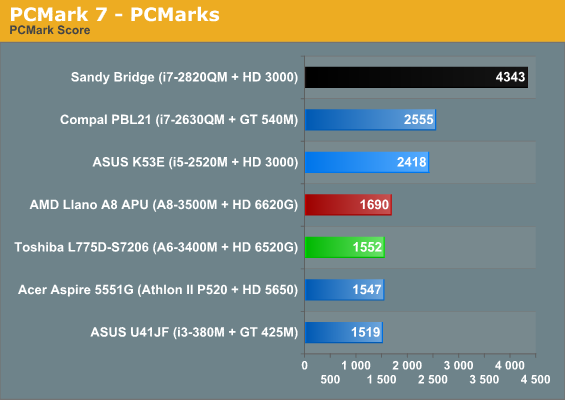
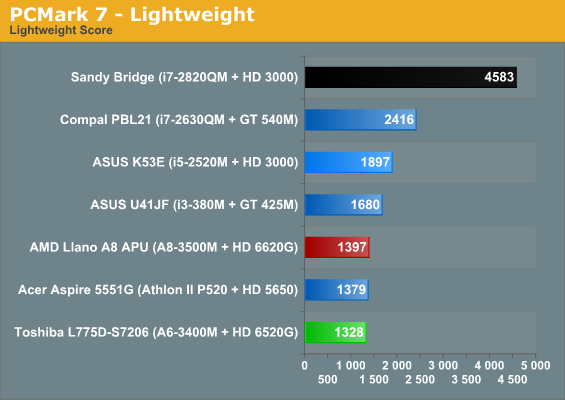
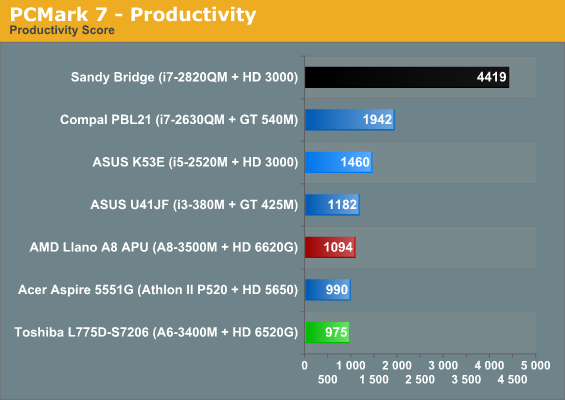
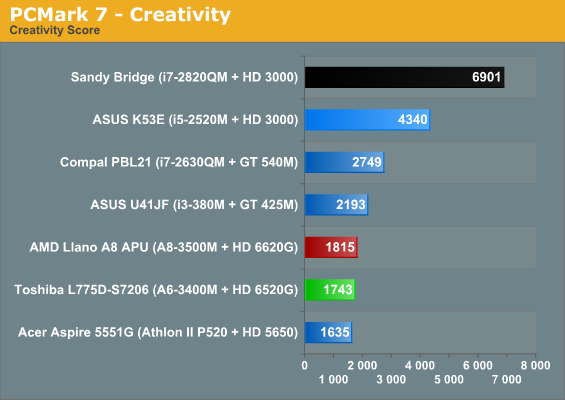
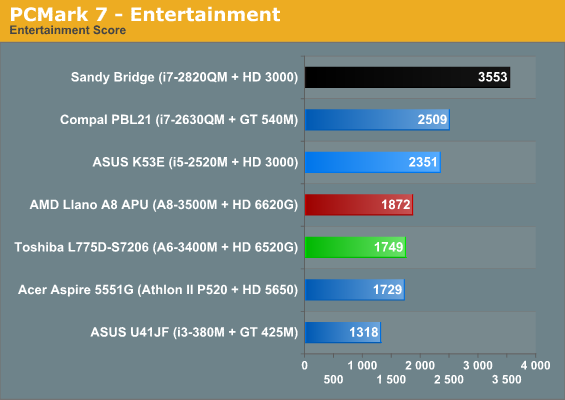

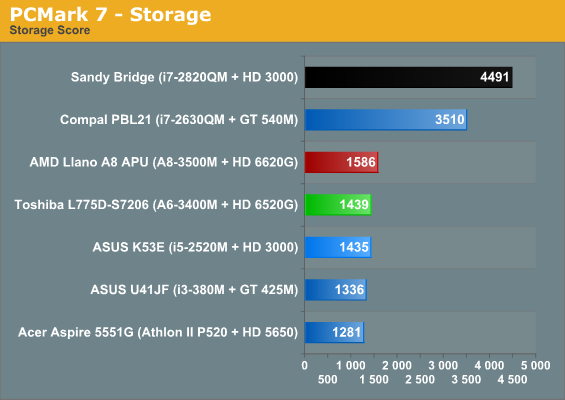
You can see in PCMark 7 that Sandy Bridge pretty much dusts the A6-3400M (noting that the quad-core Sandy Bridge test systems do benefit from SSDs), and it basically trades blows with Arrandale. The dual-core i5-2520M with an HDD is in the ASUS K53E, and outside of the storage test it also pummels Llano. What's particularly interesting, though, is that the A6-3400M is barely slower than the A8-3500M, at least in these synthetic tests. That makes sense: only 100MHz separates the two processors, but at least as far as the CPU goes you can make that sacrifice fairly comfortably since the A8 is much more rarefied in the wild than the A6. The Athlon II P520, meanwhile, boasts two cores at a nominal 2.3GHz and trades blows with the new Llano chips.

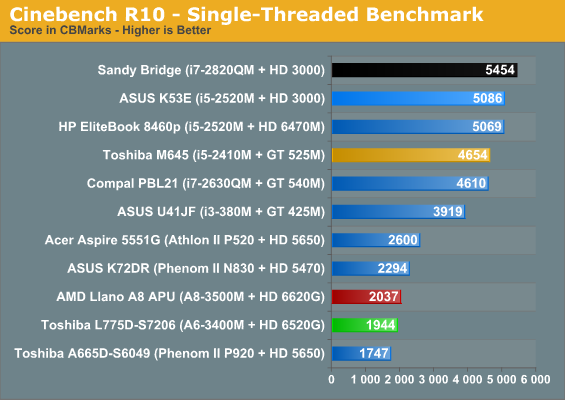
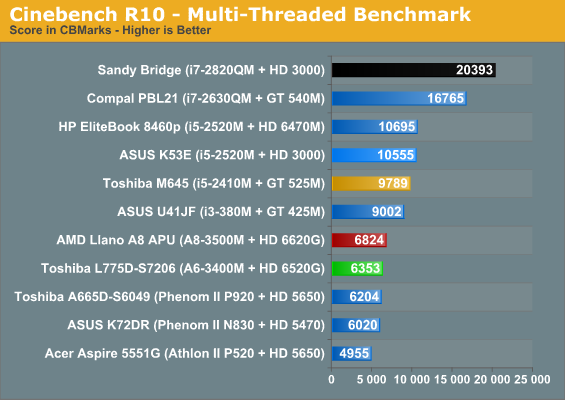
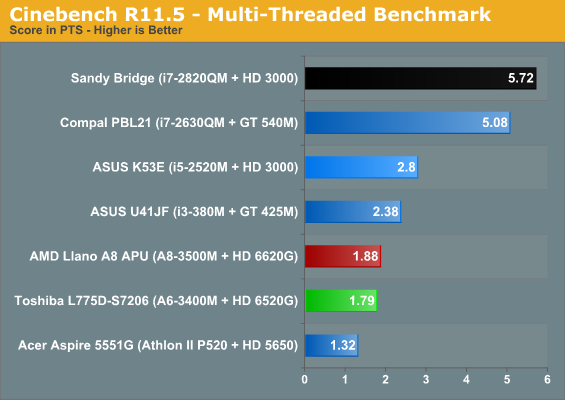
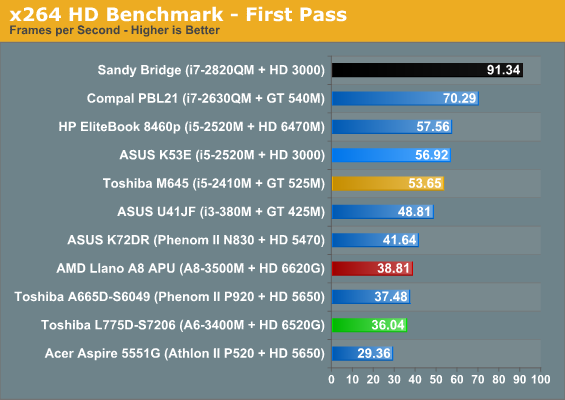
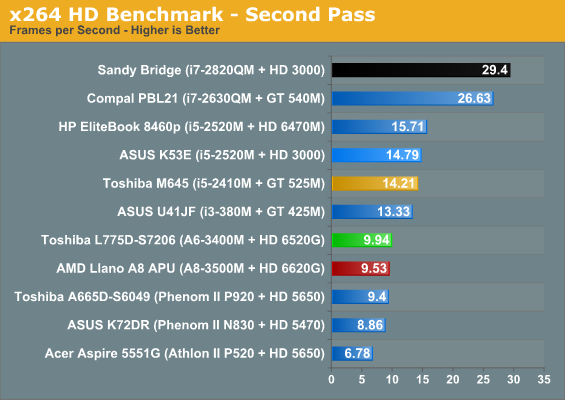
There's an awful lot to digest here. First, two of Intel's Hyper-Threaded cores running at a high clock speed basically run roughshod over four slow Stars cores: no surprsies there. But the Phenom II P920 in the Toshiba A665D-S6049 is a 1.5GHz quad core with 512KB of L2 cache per core instead of 1MB as in Llano, though the cores are otherwise almost identical. In most cases the AMD chips bunch together while the Intel chips gum up the top of the chart. The takeaway is brutal, though: Trinity, with its Bulldozer cores instead of Stars cores, can't get here fast enough. The i7-2820QM in our Sandy Bridge testbed is nearly three times faster than Llano, and the i5-2520M is about 60% faster on average.


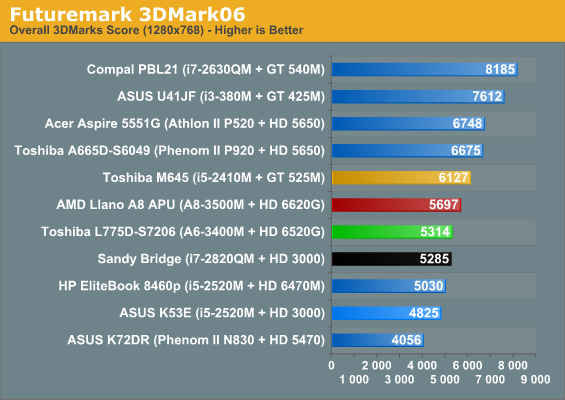
Things brighten up a bit when we get to 3DMark, where Llano's modified Redwood GPU core is able to hang fairly well with discrete-class GPUs. The A6-3400M may be closer to the bottom of the charts in each case, but it's still producing impressive performance compared to the string of dedicated graphics parts. It's easy to understand why AMD's PR splits hairs about calling Llano's graphics core an IGP and prefer to call it an "iGPU" or Fusion GPU, because while it's an IGP in the strictest sense, it doesn't necessarily deserve the negative connotations that have stigmatized the term as a result of Intel's pre-Sandy Bridge integrated graphics parts. Also worth pointing out in case you missed it is the lack of 3DMark11 results for any of the Intel IGPs; as a test that requires DX11, even Sandy Bridge can't run it without a dedicated GPU.










74 Comments
View All Comments
medi01 - Friday, August 12, 2011 - link
Let me guess. It slows down your web surfing experience, right? I mean pathetic 100Mb LAN socket on a device which 90%+ of the users would never ever use and the rest will use it only because there is no wlan. Shameless...Dustin Sklavos - Friday, August 12, 2011 - link
The issue is that it's a checkbox feature that shows up on absolutely everything these days, and if you're sharing media over your network as people are doing more and more, it's going to make a difference. The omission is silly.nitrousoxide - Friday, August 12, 2011 - link
Yeah, without this review we are already aware how awful Llano's CPU is. That is a truth given how low the frequency is. I own an Acer AS5560G with A6-3400M and I've done several tests on overclocking and undervolting the Llano.The A6-3400M can be safely undervolted from 1.05V to 0.90V without failing LinX stress test. This results in 2W power reduction in HD video playback and internet browsing, 3.5W power reduction in 3D games and up to 8W reduction in stress test. Peak temperature also drops by 12 degrees.
If you want to trade some battery life for performance, just overclock it to 1.8GHz and it runs stable at 0.95V. Then you get a 30% faster processor without consuming more power than stock A6-3400M. In fact, in stress tests, the overclocked A6-3400M consumes 4W less than stock. What about overclocking at stock voltage? At 1.05V you can bump the frequency to 2.4GHz, but this results in overheating.
As far as I know virtually every Llano can be massively undervolted or overclocked. It appears to me that AMD is too conservative with Llano's voltage and clock speeds, perhaps due to the fact that Llano is released in a hurry. They could've get a much much faster Llano just with some more tweaks.
Novaguy - Friday, August 12, 2011 - link
There are a lot of people overclocking and undervolting their HP dv6zqe's into the 2.2 and up ghz range. Apparently the chips are unlocked.I have the dv6zqe and it is going well, except the 6750M (yeah, I did the crossfire) sometimes runs hot/noisy. I have not tried overclocking/undervolting but probably will sometime in the future (probably after it goes off warranty).
I think AMD could have tweaked voltages and clocks on the better chips so that there was model that had a 2.4 stock/2.8 turbo cpu with maybe a 550 or 600 speeds on the gpu portion - that could eliminate the need for a crossfire or perhaps improve the timing so that it is a bit more symmetric. An A8-3550MX or A8-3570MX, if you will.
The other issue - for those that got MX chips, HP is only using 1333 memory chips, when it looks like 1600 mhz is supported (for the MX llano's) and would give better graphics results. This toshiba looks like it doesn't have MX chips, so 1333 is probably the max memory speed. I wish laptop manufacturers had a 1600 option.
Roland00Address - Friday, August 12, 2011 - link
It is the newest version of k10stat, correct?Novaguy - Saturday, August 13, 2011 - link
Yes, it's one of the recent versions of k10stat. Maybe the last two versions, as I vaguely remember reading that a new version came out. There are a whole bunch of tables of volts/speeds on various forums using this program.I have not personally tried undervolting/overclocking as I have not installed anything that needs more performance. So far I am just doing browsing and playing early 2000's rpgs (diablo II) and the stock speeds are sufficient. But once I finish that I might move on to something that needs more fps....
R3MF - Friday, August 12, 2011 - link
"I'd've killed for a Llano-equipped notebook that could run something like Guild Wars on the battery with good performance. There is a market for this"True, 3D battery life is a standout for Llano, but I want to see a 35W A8 Llano sporting 400 shaders shoe-horned into a 12" chassis.
Now that would be made of WIN!
Anato - Friday, August 12, 2011 - link
At the price point i5-2520M is out of the league. I'd like to see i3-2310m in the chars. Tho results AMD-Intel would be the same, Intel wins CPU-tasks AMD Graphics.oceanrock - Thursday, August 25, 2011 - link
I can tell you that the i3-2310 w/o dGPU (ACER timelineX 5830T), was faster, but not as smooth (responsive and enjoyable) as an ACER Aspire AS5253-BZ849 equipped with an E350!The i3 was constantly shifting its speed and spent most of the time at ~800 mhz and 20%utilization, the E350 spent most of the time at 1.2/1.6 ghz with 50-80%utilization. it still lasted 4-8 hours and kept real cool the whole time. the i3 was a bit louder, jerky, not as cool, but lasted 8-12 hours. Also, it cost $100 more...
Go figure???
gc_ - Friday, August 12, 2011 - link
Anandtech, could you please find a way to label laptop comparison graphs with the relevant HD/SSD model or specs? In some benchmarks the HD or SSD is more relevant than the GPU, yet the graphs seem to give all the credit/blame to the CPU or GPU. These days the CPU is often fast enough for many office/school tasks and the storage system is the bottleneck.